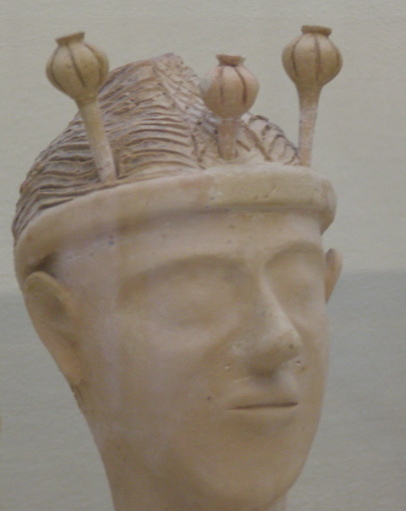Friday, October 18th, 2013
Minoans, the “Poppy Goddess” and Opium

The "Poppy Goddess," ca. 1300-1250 BCE, approx. 31" in height (79.5 cm). Terracotta, Archaeological Museum of Crete at Heraklion. Image courtesy Wikipedia
I have written before about my undergraduate professor who compared the Minoan civilization to the “hippies” of the 1960s. Today in class, I mentioned in passing that the Minoans used opium, and a question from one of my students led me to explore more of the artifacts that give evidence of opium use in Minoan culture. One sculpture that I learned about was the “Poppy Goddess.” If I have ever come across this sculpture before, I don’t remember it. After doing some research, it seems like right now this figurine is more popular in archaeological scholarship than art historical scholarship.1
Aesthetically, the “Poppy Goddess” is similar to two other Minoan female figurine types, the so-called “Bird Goddess” and “Goddess with a Cone and Horn of Consecration.” The “Poppy Goddess” is one of the artifacts that archaeologists cite to support the practice of opium use in Minoan culture. She was discovered, along with four other female figurines, at Gazi in July 1959. In the same room as these figurines, a heap of coal was found as well as some vertical vessels thought to be used for the inhalation of opium vapors.2 Classical texts reveal that opium was used for a variety of purposes in the Mediterranean, including use as a hypnotic drug to induce sleep.
On top of the Poppy Goddess’s head rest three moveable capsules of poppies. A 1967 archaeological study by Kritikos and Papdaki confirmed that these heads related to one specific type of poppy used for opium in ancient times.3 This same study also pointed out that the colors of the vertical notches also correspond to the dried juice of the poppy.2 Additionally, these archaeologists suggested in the study that the goddess might have closed eyes, to represent sleep. I think this is an interesting idea, but I would like to see if microscopic traces of paint have been on this statue. It could be that pupils were painted onto the statue that have disappeared over time.
I hope that more discussion about this figurine can take place amongst art historians, since I haven’t found some in-depth artistic analyses of this figurine yet. (If you know of any more scholarly discussion about this figurine, please share in the comments!) Here are some questions that the Poppy Goddess raises for me, from an art historical standpoint:
- Why are the opium capsules moveable? Was there an additional function or purpose for these capsules, apart from their placement in the head? Are the capsules moveable simply because they were fashioned separately?
- Does the woven cap have any significance? The artist took great pains to decorate this cap with incisions, whereas much of the body has a smooth texture.
- What is wrapped around her neck? What does this scarf-like object look like from the back of the figurine? I wonder if it ends in a sacral knot, similar to some other depictions of priestesses (I’m thinking of the “La Parisienne” fresco at Knossos.)
- Is this sculpture hollow, if it is made of terracotta? Is there an open bottom? Could it be that the holes in her head (when the opium capsules are removed) could waft vapors of opium, similar to the vessels which were found in the room with this figurine? (This is just a wild idea, but I’m going to throw it out there.)
I think it is also important to note that the poppy, because of its multiplicity of seeds, could also serve as a symbol of fertility in ancient times. Given the associations with other Minoan female figurines and fertility (most notably the famous Minoan “Snake Goddesses,” one of which also appears with upraised arms as a symbol of power), it is important to acknowledge that this statuette might serve a similar function.
Do you know anything else about this figurine or the other terracotta figurines found on Crete?
1One relatively recent discussion on the Minoans and opium is by Helen Askitopoulou, Ioanna A Romoutski, and Elini Konsolaki, “Archaeological Evidence of the Use of Opium in the Minoan World” in International Congress Series 1242, (December 2002): 23-29. Article can be found HERE.
2 We also know that ancient cultures would ingest the “juice” of opium, and some think that smoking opium was another method of intake. See P.G. Kritikos and S.P. Papdaki, “The History of the Poppy and of Opium and Their Expansion in Antiquity in the Eastern Mediterranean Area,” in Journal of the Archaeological Society of Athens: 1967. Available online HERE.
3 Ibid.

On top of the Poppy Goddess’s head rest three moveable capsules of poppies. A 1967 archaeological study by Kritikos and Papdaki confirmed that these heads related to one specific type of poppy used for opium in ancient times.